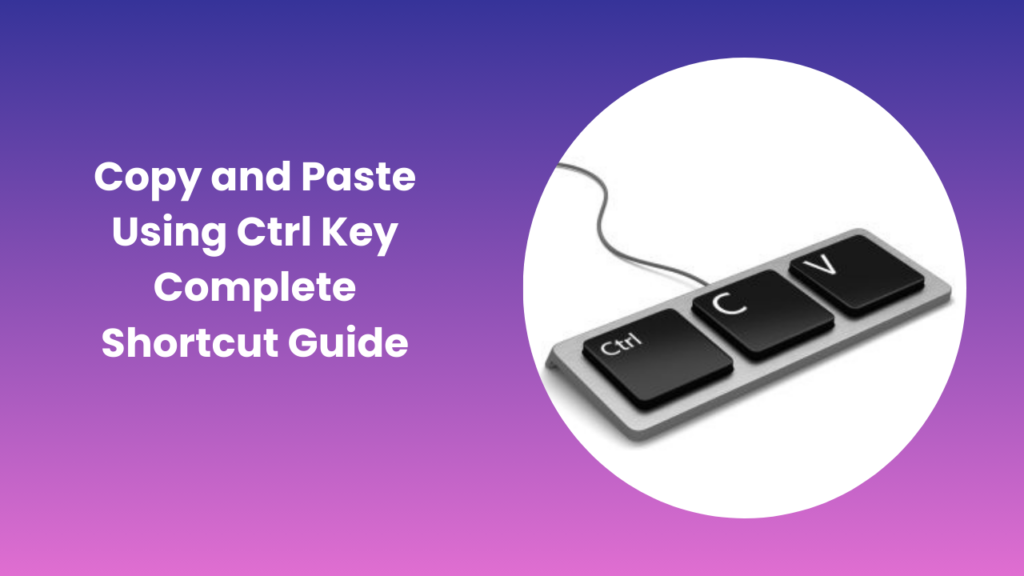In the fast-paced digital world, efficiency is everything. Whether you are a student working on assignments, an office professional handling reports, or a casual computer user, learning simple shortcuts can save hours of work each week. Among the most essential shortcuts to know is copy and paste using ctrl key, a technique that has stood the test of time in helping people manage text, images, and data across applications. Though it seems like a small action, mastering this shortcut enhances productivity, improves accuracy, and reduces unnecessary effort. This guide will walk you through its history, importance, and practical uses, while also exploring the broader context of keyboard shortcuts that shape our daily digital experiences.
The Origins of Keyboard Shortcuts
Keyboard shortcuts have existed for decades, dating back to the early days of computing. Before graphical user interfaces became mainstream, most computer operations relied heavily on typed commands. The idea of using control keys to trigger functions was revolutionary, as it simplified processes that previously required multiple steps. The Ctrl key in particular became a central feature, acting as a modifier that could be combined with other keys to perform specific tasks. Over time, these shortcuts became standardized across operating systems, ensuring that users could rely on them consistently regardless of whether they were on Windows, macOS, or Linux.
Why Keyboard Shortcuts Matter in the Modern World
Technology continues to evolve, but one truth remains constant: time is valuable. Keyboard shortcuts are not just conveniences; they are tools that allow users to navigate software more efficiently. By eliminating the need to rely entirely on a mouse or trackpad, shortcuts keep workflows fluid. For professionals who deal with large volumes of data or complex projects, the ability to act quickly using combinations like Ctrl+C and Ctrl+V translates into significant productivity gains. Furthermore, shortcuts also enhance accessibility for individuals who may find repeated mouse movements challenging.
How the Ctrl Key Became a Universal Command Tool
The Ctrl key is present on nearly every keyboard layout worldwide, symbolizing its importance. Its widespread adoption means that software developers design applications with Ctrl shortcuts as a built-in expectation. Word processors, spreadsheets, browsers, and even creative design tools have embraced the same core combinations, making them second nature to millions of people. This consistency reduces the learning curve for new programs and ensures a smoother transition when switching between platforms.
Everyday Applications of Copy and Paste
Copy and paste is one of the most frequently used commands in the computing universe. From moving text in a document to duplicating formulas in a spreadsheet, it has countless practical applications. Writers often rely on it to restructure drafts, while researchers use it to transfer information between sources. Designers can duplicate elements without manually recreating them, and even casual users benefit when sending messages or organizing notes. Its universality makes it an indispensable digital habit that simplifies both professional and personal tasks.
Copy and Paste in Word Processing
Word processors such as Microsoft Word and Google Docs showcase the full power of this command. Instead of retyping paragraphs, users can instantly copy and reposition them. Editing becomes smoother, as content can be reorganized with minimal effort. This ability is especially valuable for students writing essays or professionals drafting reports, where structure and clarity often require moving information around multiple times.
Copy and Paste in Data Management
Spreadsheets rely heavily on copy and paste functionality. Accountants, analysts, and business managers depend on it to duplicate data sets, formulas, and formatting. What would take hours through manual entry becomes a matter of seconds with a few keystrokes. The time saved compounds over large projects, proving why keyboard mastery is essential in data-driven industries.
Copy and Paste in Creative Work
Design software and multimedia platforms also embrace this command. Whether it’s duplicating a shape in Photoshop, reusing elements in a video editing timeline, or replicating audio clips, copy and paste ensures precision and speed. For creators, this shortcut is more than a convenience; it’s a way to maintain consistency and streamline production.
The Efficiency of Copy and Paste Using Ctrl Key
Although modern devices often come with touchscreen interfaces, the keyboard still reigns supreme for productivity. Copy and paste using ctrl key remains the fastest and most reliable way to transfer information across applications. Touch gestures and right-click menus provide alternatives, but the simplicity of pressing two keys together is unmatched. The muscle memory developed from repeated use allows people to perform the action almost unconsciously, further reducing cognitive load and allowing them to focus on more complex tasks.
The Psychology Behind Keyboard Shortcuts
Human beings thrive on habits, and keyboard shortcuts exemplify this principle. Once a shortcut becomes second nature, it reduces the mental effort required to complete routine actions. This phenomenon is known as cognitive offloading—shifting small repetitive tasks from conscious thought to automatic response. Over time, this not only saves time but also improves accuracy, as fewer errors occur when a command is executed instinctively. The copy and paste shortcut, therefore, represents not just a technical tool but also a psychological advantage in digital environments.
Cross-Platform Consistency and User Trust
One of the reasons shortcuts like Ctrl+C and Ctrl+V have endured is their universality. Regardless of the device or software, users trust that these combinations will work the same way. This consistency is rare in the technology industry, where standards often differ across brands and systems. By maintaining uniformity, copy and paste commands have become a cornerstone of digital literacy, empowering users of all ages to interact with technology more confidently.
Misconceptions About Copy and Paste
While the shortcut seems straightforward, there are misconceptions surrounding its use. Some beginners assume that copied data is permanently stored, when in fact it resides temporarily in the clipboard until replaced or cleared. Others worry about formatting inconsistencies when pasting text into new programs, not realizing that options like “Paste without formatting” exist to solve this issue. Addressing these misunderstandings helps users get the most out of this powerful tool while avoiding frustration.
Enhancing Productivity Beyond Basic Shortcuts
Once users master copy and paste, they often begin to realize that it is only the starting point of a much larger world of efficiency. The true power of the keyboard is unlocked when complementary shortcuts are added into daily routines. For example, the cut command (Ctrl+X) allows content to be removed from one place and quickly inserted elsewhere, reducing unnecessary duplication. Undo (Ctrl+Z) and redo (Ctrl+Y) provide safety nets for experimentation, giving users the confidence to edit and adjust without fear of losing important work. Together, these commands create a reliable framework for navigating documents, spreadsheets, and creative projects with ease.
The benefits extend far beyond simple text editing. In design environments, cut, undo, and redo commands allow for precise adjustments to complex visual elements, while in programming they make it easier to test new code without worrying about permanent mistakes. Writers and researchers also gain freedom, as they can restructure large blocks of content knowing that any action can be instantly reversed. The ability to move fluidly between creating, editing, and refining ideas without breaking focus is what transforms a basic user into a highly efficient one.
The Future of Keyboard Shortcuts
As technology continues to evolve at a rapid pace, questions often arise about the long-term relevance of traditional keyboard shortcuts. With new devices relying on touch screens, voice recognition, and gesture controls, it may seem like the keyboard’s role could eventually diminish. However, reality points in a different direction. Rather than fading away, shortcuts are adapting to new platforms and remain integral to productivity in the digital age.
Artificial intelligence is already reshaping the way people interact with technology, but instead of replacing shortcuts, it often enhances them. For instance, AI-powered applications may predict what a user is likely to copy and paste, or even suggest formatting improvements automatically, yet the fundamental control offered by keyboard shortcuts continues to be essential. Similarly, in virtual and augmented reality environments, developers are finding ways to integrate traditional commands into new interaction models, ensuring that efficiency is not lost in the pursuit of innovation.
FAQs
What is the purpose of the Ctrl key?
The Ctrl key functions as a modifier that, when combined with other keys, triggers commands. It enables shortcuts that replace longer manual processes, making computer use faster and more efficient.
Why is copy and paste considered one of the most important shortcuts?
Copy and paste is essential because it saves time, prevents errors, and provides flexibility across nearly all digital platforms. From documents to design tools, it allows users to move information seamlessly without duplication of effort.
How does the clipboard work when copying and pasting?
When something is copied, it is stored temporarily in a hidden area of memory called the clipboard. The clipboard holds the information until something else is copied or the system is restarted. Pasting retrieves that information and places it in the selected location.
Are there risks in relying too heavily on copy and paste?
Yes, while convenient, over-reliance can sometimes reduce comprehension. For instance, students who copy and paste information from research sources without processing it may retain less knowledge. However, when used responsibly, it is a valuable time-saving strategy.
Do copy and paste commands work across all devices?
Most modern devices support the same shortcuts, though mobile platforms may rely more on touch-based alternatives. On traditional computers, the Ctrl key is standard, while on Mac systems the Command key provides similar functionality.
What happens if formatting changes when I paste text?
Formatting differences arise because applications interpret text styles differently. Many programs provide options like “Paste as plain text” to ensure consistency. Understanding these options helps users avoid unnecessary adjustments.
Conclusion
Digital efficiency often hinges on small yet powerful habits, and few are as universally transformative as mastering the Copy and Paste Using Ctrl Key. This seemingly simple keyboard command has become a cornerstone of digital interaction across nearly every platform, from word processors and spreadsheets to graphic design software and web browsers. Its power lies not just in moving text, images, or files from one place to another, but in the way it fundamentally streamlines work, saving users significant time and effort. Beyond mere convenience, it enhances accuracy by reducing the chances of manual errors that often occur when information is transferred manually. Despite being decades old, this command has not lost its relevance; instead, it has adapted to modern technological ecosystems, integrating seamlessly with cloud applications, collaboration tools, and even mobile interfaces. Professionals in every industry from writers and programmers to designers and analysts rely on this function daily to boost productivity and maintain workflow consistency.





